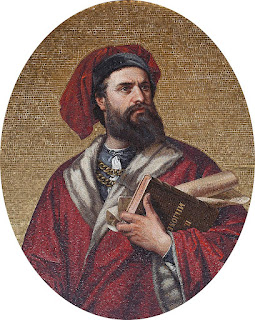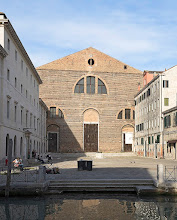Wealthy woman dedicated her life to relieving poverty
The Feast Day of Virginia Centurione Braccelli, a noble lady from Genoa, who was made a Saint by Pope John Paul II, is celebrated every year on this day throughout Italy and in other parts of the world. Virginia died on December 15, 1651 in her native city after devoting her life to helping the poor and the sick.
Virginia defied her father in order to
help the poor and sick in Genoa
Virginia was born in 1587 to Giorgio Centurione, who was the Doge of Genoa between 1621 and 1623, and his wife, Lelia Spinola. At that time, the Doge was the Head of State of the maritime Republic of Genoa.
Her mother was very pious and as a young girl Virginia spent a lot of time with her mother in prayer and contemplation. She could also hear her brother’s Latin lessons as she sat sewing and because she took in everything she heard, she learnt the language of the church. She was able to read passages of scripture in Latin and learn them by heart and meditate on them.
But after her mother’s death, although Virginia wanted to take holy orders, her father forced her to marry a rich nobleman, Gaspare Grimaldi Bracelli, when she was still only 15 years old. She bore him two daughters, Lelia and Isabella.
After her husband’s death, when Virginia was still only 20, she refused to have a second marriage arranged by her father and she made a vow to live a celibate life and to work to help poor and sick people in Genoa. She lived in her mother-in-law’s house, where she looked after her daughters and devoted herself to charitable work, sharing her own wealth with the needy.
Following Genoa’s involvement in a war in 1624, unemployment rose and there was an increase in the number of starving people in the city. It led Virginia to found a centre to accommodate some of the people living in poverty because she could not house them all in her home. The centre soon became overrun with people who were suffering as a result of either famine or the plague and she had to rent a convent to accommodate all the people who needed help.
Virginia created a community at the convent dedicated to Our Lady of Refuge, which she later split into two separate congregations, The Sisters of Our Lady of Refuge and the Daughters of Our Lady of Refuge.
By 1635, the centre was caring for more than 300 patients at any one time and it received official recognition as a hospital. Virginia trained the poor people she was caring for to gain employment so that they could eventually work to provide themselves with sustenance and she also earned extra money herself by teaching the catechism, the text that summarises the doctrine of the Catholic faith.
 |
| Virginia's body was found to be incorrupt almost 300 years after her death |
The work of the Sisters of Our Lady of Refuge in Monte Calvario continues to this day with the sisters working to help sick, poor, and elderly people in hospitals, and also young people as far afield as Nicaragua, the Dominican Republic and India.
The process for making Virginia a Saint was started in 1933, with theologians approving her writings and historians assessing the cause and clearing it to allow it to continue.
In 1977, Pope Paul VI accorded Virginia the title of Servant of God. She was made Venerable in 1984, Beatified in 1985, and Canonised by Pope John Paul II in 2003.
When Virginia’s remains were examined during the long process leading up to her Beatification and Canonisation, they were found to be in a remarkable state of preservation and officially classified as incorrupt.
While not a prerequisite for sainthood, the incorruptibility of an individual’s remains is considered by the Catholic Church as strong evidence of sanctity, a miraculous sign of divine favour, showing that the saint lived a life of purity and closeness to God.
Travel tip:.jpg)
The Marassi district is best known for its football
stadium, the Stadio Luigi Ferraris
Virginia Centurione Braccelli’s remains are buried within the chapel of the religious congregation she founded, the Sisters of Our Lady of Refuge in Mount Calvary, in the Marassi district of Genoa, a hillside area east of the city centre overlooking the Bisagno valley. The sanctuary is thought to have roots going back to the 16th century, having been originally built on the site of a chapel dedicated to Saint Raphael. It was relocated to Marassi in the 19th century after the church in central Genoa where it was originally based was demolished to make way for the Brignole railway station. The Marassi district, known as a lively, authentic neighbourhood away from the regular tourist trails, is most famous as the home of the Stadio Luigi Ferraris - also known as Stadio Marassi - which is shared by the city’s two major football clubs, Genoa and Sampdoria. The former, which still goes under the official title of Genoa Cricket and Football Club, was founded in 1893 by a group of British Consular officials. Among existing football clubs, it is the oldest in Italy.
Find accommodation in Genoa with Hotels.com
Travel tip:
Piazza De Ferrari, at the heart of Genoa's elegant
city centre, with its impressive bronze fountain
The port city of Genoa, the capital of the Liguria region, has a rich history as a powerful trading centre with considerable wealth built on its shipyards and steelworks. It also boasts some fine buildings, many of which have been restored to their original splendour. The Palazzo Ducale - the Doge's Palace - the 16th century Palazzo Reale, a lavish royal residence with frescoes, tapestries and a rooftop garden, and the Romanesque-Renaissance style San Lorenzo Cathedral, with its striking black-and-white façade, are just three examples. At the heart of the city centre is the Piazza De Ferrari, which features a monumental bronze fountain and is flanked by the Palazzo Ducale, the Palazzo della Borsa and the Teatro Carlo Felice among other buildings. The area around the restored harbour area offers a maze of fascinating alleys and squares, enhanced recently by the work of Genoa architect Renzo Piano, and a landmark aquarium, the largest in Italy.
Find hotels in Genoa with Expedia
More reading:
The secret gift maker who has become known as Santa Claus
The noblewoman who gave up luxurious lifestyle to help the poor
A reformed gambler who became devoted to caring for sick
Also on this day:
1946: The birth of footballer Comunardo Niccolai
1966: The Good, the Bad and the Ugly released in Italy
1970: The birth of champion jockey Frankie Dettori
1973: Kidnappers release John Paul Getty III
.



.jpg)















-panorama_novembre_2019.jpg)









.jpg)

